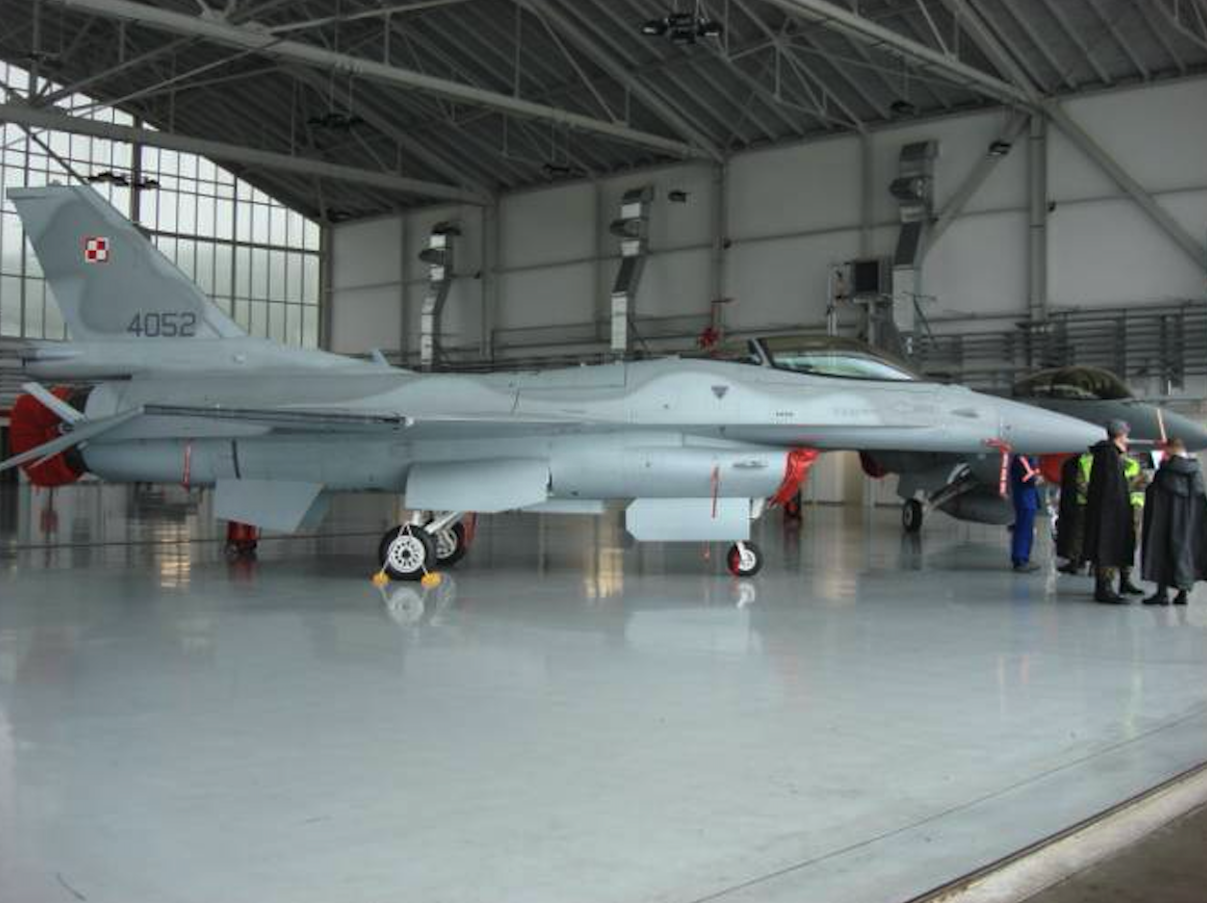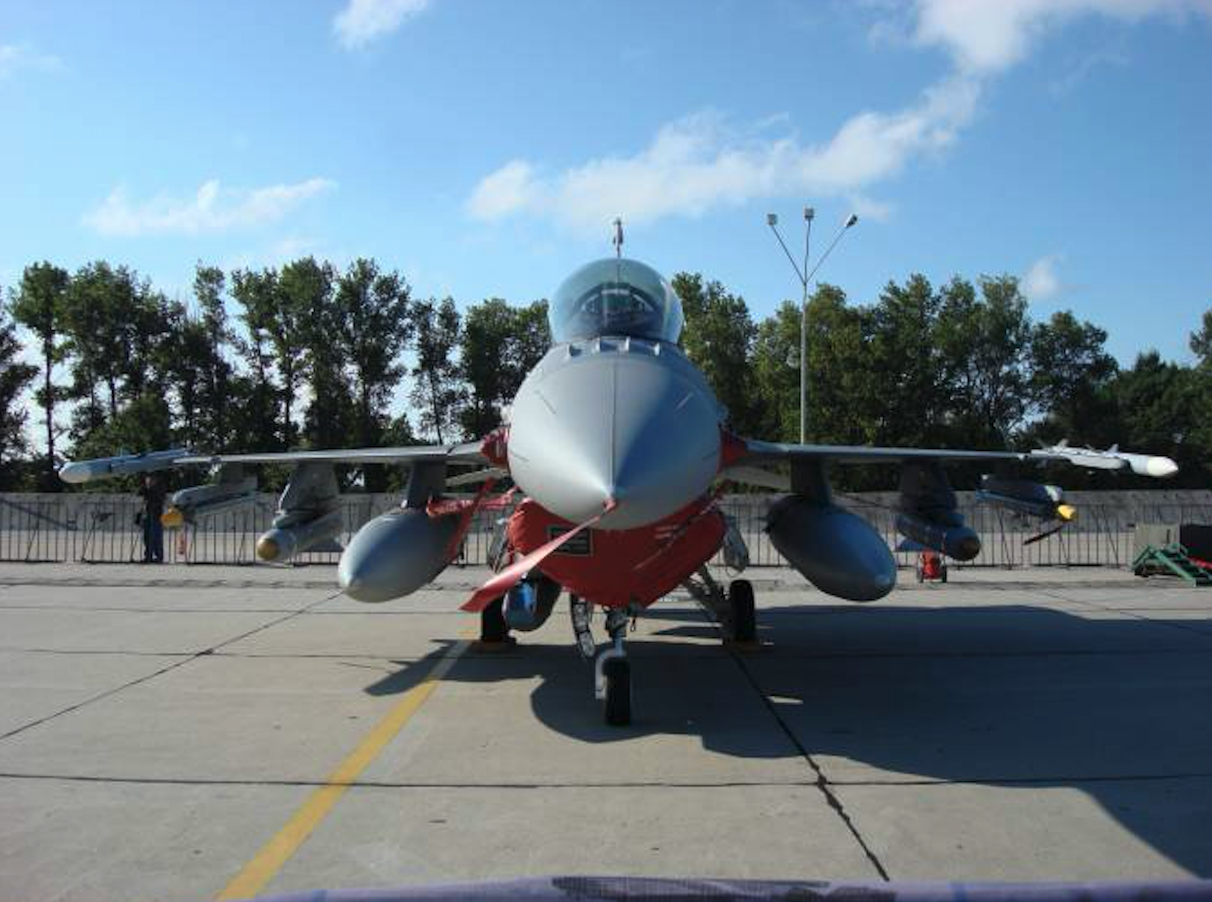Poznań 2013-10-21
The airport in Krzesiny near Poznań.
Geographic coordinates: 52.333N 16.963E.
To be continued.
Efforts to acquire modern multi-task combat aircraft by the Polish Military Aviation took as long as 14 years. During this time, there were numerous mock activities and behind-the-scenes gameplay. Nevertheless, in 2003, it was possible to sign a contract for the supply of 48 F-16 WSBs. On April 18, 2003, an agreement with Lockheed Martin was signed at the WSO of the Air Force in Dęblin. Delivery date 2006 – 2008.
This number of 48 machines meant that they would be machines that would provide armament for three squadrons (16 machines each). The Ministry of National Defense has selected the following bases (airports) for future machines; Krzesiny, Łask and Powidz. And thus the appropriate squadrons; 3. ELT, 10. ELT, 6. ELT. As the F-16 is a completely different philosophy of flying and handling, it turned out that these airports had to be built almost from scratch. A completely new infrastructure was needed for these machines. The state budget had to find funds for both the purchase of machinery and the modernization of airports.
At this point, let us also remind you that at the turn of 2002 and 2003, while the contract was being added, the Polish side was officially talking about the purchase of another 32 F-16 machines (not necessarily new ones) to replace the Su-22 M 4 attack aircraft. the period 2010-2012 It did not happen.
In the period 2001 – 2007, the Krzesiny airport (similarly to the Łask and Powidz airports) underwent a thorough modernization.
The first facility modernized at Krzesiny Airport was the renovation of RWY, which was completed in 2001. For laying the concrete, modern road construction machines with a working width of 10 m were used. On November 29, 2003, a new hangar for WSB was commissioned. It has 115 m x 45 m at the base and a volume of 47,000 cubic meters. The main halls of the hangar are made of steel. In the two-nave main hall measuring 61 m x 25 m, there are six aircraft stands in two rows. Two single-bay single-bay halls and accompanying rooms were also built. The halls are equipped with electric-powered gates (main hall and engine hall) and manually operated gates in the fuel hall.
The base received a new port with a launch tower. Identical buildings were built in Łask and Powidz. The building has a usable area of 2,500 square meters and a cubic volume of 11,200 cubic meters. On the seventh floor there is an air traffic control tower, commonly known as an aquarium. New composition of propellants and lubricants meeting environmental protection standards. Building with trainers. The barracks for the professional corps of the privates were renovated. Several new shelter-hangars were built, in a new centering zone, in line with NATO standards. Heavy type shelters make it possible to start aircraft engines inside. The new centering zone received; technical buildings, a building for pilots, shelters for service and concealment for motor vehicles. Built; a new facility of the airport fire brigade, a parachute. New fences were put up. Some facilities have individual fencing throughout the complex.
During these works, 600,000 square meters of smoothing and slip layers, 350,000 square meters of B-40 concrete pavements and 115,000 square meters of bituminous surface were laid. The agrotechnical works were carried out on an area of 500,000 square meters of grassy surfaces.
Infrastructure is important, but hardware is important. AS-900 multifunctional airport vacuum cleaners on Mercedes chassis were purchased, rescue and firefighting vehicles on MAN 19,364 FAC chassis, LUZES starters on STAR 994 chassis, M-TET-30 mobile platform with a lifting capacity of 13 tons, HIAB 800 ET-5 self-loading crane.
A novelty on the scale of the Air Force was the fact that the unit is a direct recipient of aviation materials that come directly from the USA. The base in Krzesiny is the first in this respect. Until now, it was so that the means of supply were sent to material bases, and only later to units. The structure of the technical division includes an expedition section whose role is to accept these supplies from abroad and deal with customs and fiscal procedures. In December 2005, the first trial delivery of equipment and materials necessary for the operation of the F-16 aircraft took place. It was about checking many matters, for example practical training of customs and fiscal procedures – whether the persons responsible for it are properly prepared to fill in the necessary documentation, whether the reloading equipment will allow to secure unloading. The first larger shipments were made in the second quarter of 2006. They arrived by sea, land and air.
The air bases in Krzesiny and Łask have been equipped with modern communication, navigation and flight insurance systems TACAN (Tactical Air Navigation), GCA (Ground Control Approach) and ILS (Instrument Landing System), compatible with NATO systems. According to LOA, the Air Force received IT systems for managing the technical documentation of the F-16 aircraft. Lockheed Martin provided an IT system for airframe and avionics – International Technical Order Digitization (ITOD), and Pratt & Whitney provided an IT system for engine support – Interactive Electronic Technical Manual (IETM). The rest of the documentation (Technical Order) provided by the US Air Force is partially open and confidential. As the Polish side provides the entire ICT infrastructure for these systems, local LAN computer networks and an extensive WAN computer network including air bases and the Air Force Command have been built at the airports in Krzesiny and in Łask. According to LOA, the Polish Air Force received 200 computers for the IT security of the F-16. Other IT equipment was purchased: printers, active elements of computer networks, software. The Polish F-16s are equipped with the latest automated command system, based on the Link 16 tactical radio data distribution system. Therefore, ADSI (Air Defense System Integrator) devices were purchased to integrate the data exchange systems with the previously existing automated command system. In 2006. Link 16 network design and monitoring devices were implemented. An electronic warfare laboratory was built for the needs of the F-16 aircraft. It was built in a new hangar at the Krzesiny air base. This laboratory is the first in the Polish Armed Forces to analyze and program the database of threats related to the aircraft.
Krzesina’s base for F-16 receptions was ready on June 30, 2006, although some less important programs were completed in 2007. Krzesiny became the first Air Base where only professional and contract soldiers work. The training of Polish pilots and F-16 technicians began in 2004 in the USA. On November 15, 2005, the first Polish soldier, pilot, Lt. Col. Rościsław Stefaniuk, made the first solo flight. It was in the USA. I write a lot about Polish pilots and F-16 technicians in other chapters.
Further changes took place in the structures of the Polish Military Aviation. In 2005, the Corps were disbanded and replaced with Brigades. In July 2005, the 31st BLot, so far subordinate to the 3rd Air Corps, was subordinated to the 2nd Tactical Aviation Brigade, which in 2009 was transformed into the 2nd Tactical Aviation Wing.
F-16 Jastrząb for Poland. 2006.
F-16 C planes have tactical numbers from 4040 to 4075 (in the USAF register: FY 03-0040 to FY 03-0075), and the F-16 D – from 4076 to 4087. On March 15, 2006, Lockheed Martin Aeronautics Company (LMAC) informed about the flight of the first Polish multi-role plane F-16 C Block 52 M + No. 4040. The plane, piloted by the pilot tester of the company Paul Hattendorf, flew on March 14, 2006, from the Fort Worth plant airport for a test flight lasting over an hour.
On November 8, 2006, at 15:02, the first two Polish multi-role F-16 C planes No. 4043, 4044 landed at the airport of the 31st Air Base in Krzesiny. New planes with obscured identification marks flew over the airport, assisted by two Polish MiG-29s. The planes were brought in by Yankee pilots. "The flight was very successful, I’m glad I landed successfully," US Air Force Col. Mike Meyer, who was piloting the F-16 No. 4044, told reporters. on site in Poland. "These are not serious faults," added Col. Mike Meyer. Journalists gathered at the airport wanted to find out why the planes arrived later than announced and whether the Krzesiny base was fully ready for F-16 service. , we agreed with the manufacturer that they will be in Poland at the ceremonial takeover on Thursday and have landed. As for the second question, if the base had not been ready, these planes would not have landed here ", said the spokesman for the commander of the Air Force, Major Stanisław Grzegorzewski.
The first two F-16 planes were to arrive in Poland on Monday (November 6, 2006), but they returned to the USA due to a fault. The representative of the Minister of Defense for the implementation of the F-16, Piotr Łukaszewicz, asked the American side for explanations regarding the defects that delayed the arrival of the first aircraft of this type to Poland, the spokesman for the Ministry of National Defense, Piotr Paszkowski, informed on Wednesday (November 8, 2006). He added that the director of the F-16 office at the Ministry of National Defense expects an answer on Friday.
Written by Karol Placha Hetman


